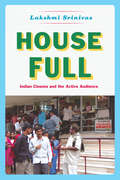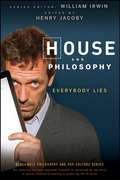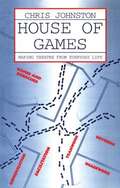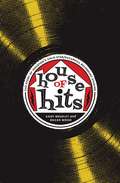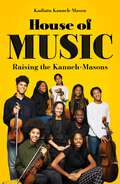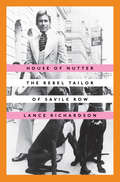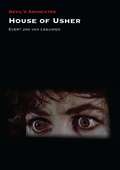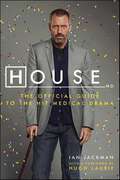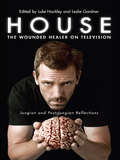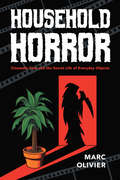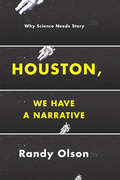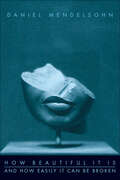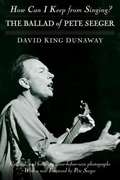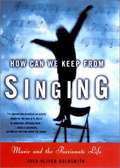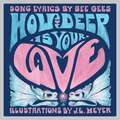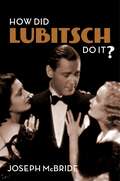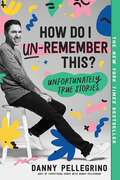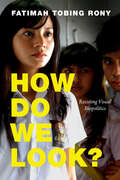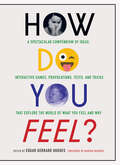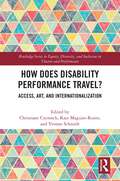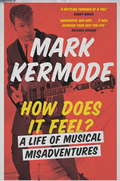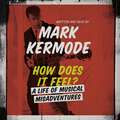- Table View
- List View
House Full: Indian Cinema and the Active Audience (Fieldwork Encounters and Discoveries)
by Lakshmi SrinivasIndia is the largest producer and consumer of feature films in the world, far outstripping Hollywood in the number of movies released and tickets sold every year. Cinema quite simply dominates Indian popular culture, and has for many decades exerted an influence that extends from clothing trends to music tastes to everyday conversations, which are peppered with dialogue quotes. With House Full, Lakshmi Srinivas takes readers deep into the moviegoing experience in India, showing us what it's actually like to line up for a hot ticket and see a movie in a jam-packed theater with more than a thousand seats. Building her account on countless trips to the cinema and hundreds of hours of conversation with film audiences, fans, and industry insiders, Srinivas brings the moviegoing experience to life, revealing a kind of audience that, far from passively consuming the images on the screen, is actively engaged with them. People talk, shout, whistle, cheer; others sing along, mimic, or dance; at times audiences even bring some of the ritual practices of Hindu worship into the cinema, propitiating the stars onscreen with incense and camphor. The picture Srinivas paints of Indian filmgoing is immersive, fascinating, and deeply empathetic, giving us an unprecedented understanding of the audience's lived experience--an aspect of Indian film studies that has been largely overlooked.
House and Philosophy: Everybody Lies
by Henry JacobyAn unauthorized look at the philosophical issues raised by one of today's most popular television shows. "House" is one of the top three television dramas on the air, pulling in more than 19 million viewers for each episode. This latest book in the popular Blackwell Philosophy and Pop Culture series takes a deeper look at the characters and issues raised in this Emmy Award-winning medical drama, offering entertaining answers to the fascinating ethical questions viewers have about Dr. Gregory House and his medical team.
House of Games
by Chris JohnstonAn immensely valuable resource book for drama leaders, House of Games is a how-to book for building up drama troupes and keeping them creative. House of Games is sure to take its place alongside the most established drama method texts.
House of Hits
by Andy Bradley Roger WoodFounded in a working-class neighborhood in southeast Houston in 1941, Gold Star/SugarHill Recording Studios is a major independent studio that has produced a multitude of influential hit records in an astonishingly diverse range of genres. Its roster of recorded musicians includes Lightnin’ Hopkins, George Jones, Willie Nelson, Bobby “Blue” Bland, Junior Parker, Clifton Chenier, Sir Douglas Quintet, 13th Floor Elevators, Freddy Fender, Kinky Friedman, Ray Benson, Guy Clark, Lucinda Williams, Beyoncé and Destiny’s Child, and many, many more. In House of Hits, Andy Bradley and Roger Wood chronicle the fascinating history of Gold Star/SugarHill, telling a story that effectively covers the postwar popular music industry. They describe how Houston’s lack of zoning ordinances allowed founder Bill Quinn’s house studio to grow into a large studio complex, just as SugarHill’s willingness to transcend musical boundaries transformed it into of one of the most storied recording enterprises in America. The authors offer behind-the-scenes accounts of numerous hit recordings, spiced with anecdotes from studio insiders and musicians who recorded at SugarHill. Bradley and Wood also place significant emphasis on the role of technology in shaping the music and the evolution of the music business. They include in-depth biographies of regional stars and analysis of the various styles of music they represent, as well as a list of all of Gold Star/SugarHill’s recordings that made the Billboard charts and extensive selected historical discographies of the studio’s recordings.
House of Music: Raising the Kanneh-Masons
by Kadiatu Kanneh-MasonSeven brothers and sisters. All of them classically trained musicians. One was Young Musician of the Year and performed for the royal family. The eldest has released her first album, showcasing the works of Clara Schumann. These siblings don&’t come from the rarefied environment of elite music schools, but from a state comprehensive in Nottingham. How did they do it? Their mother, Kadiatu Kanneh-Mason, opens up about what it takes to raise a musical family in a Britain divided by class and race. What comes out is a beautiful and heartrending memoir of the power of determination, camaraderie and a lot of hard work. The Kanneh-Masons are a remarkable family. But what truly sparkles in this eloquent memoir is the joyous affirmation that children are a gift and we must do all we can to nurture them.
House of Nutter: The Rebel Tailor of Savile Row
by Lance RichardsonThe strange, illuminative true story of Tommy Nutter, the Savile Row tailor who changed the silhouette of men’s fashion—and his rock photographer brother, David, who captured it all on film. From an early age, there was something different about Tommy and David Nutter. Growing up in an austere apartment above a café catering to truck drivers, both boys seemed destined to lead rather humble lives in post-war London—Tommy as a civil servant, David as a darkroom technician. Yet the strength of their imagination (plus a little help from their friends) transformed them instead into unlikely protagonists of a swinging cultural revolution. In 1969, at the age of twenty-six, Tommy opened an unusual new boutique on the “golden mile” of bespoke tailoring, Savile Row. While shocking a haughty establishment resistant to change, “Nutters of Savile Row” became an immediate sensation among the young, rich, and beautiful, beguiling everyone from Bianca Jagger to the Beatles—who immortalized Tommy’s designs on the album cover of Abbey Road. Meanwhile, David’s innate talent with a camera vaulted him across the Atlantic to New York City, where he found himself in a parallel constellation of stars (Yoko Ono, Elton John) who enjoyed his dry wit almost as much as his photography. House of Nutter tells the stunning true story of two gay men who influenced some of the most iconic styles and pop images of the twentieth century. Drawing on interviews with more than seventy people—and taking advantage of unparalleled access to never-before-seen pictures, letters, sketches, and diaries—journalist Lance Richardson presents a dual portrait of brothers improvising their way through five decades of extraordinary events, their personal struggles playing out against vivid backdrops of the Blitz, an obscenity trial, the birth of disco, and the devastation of the AIDS crisis. A propulsive, deftly plotted narrative filled with surprising details and near-operatic twists, House of Nutter takes readers on a wild ride into the minds and times of two brilliant dreamers.
House of Usher (Devil's Advocates)
by Evert van LeeuwenDespite being the product of Roger Corman’s AIP exploitation studio, House of Usher enjoys a high standing. But while the impact and cult status of Corman’s Edgar Allan Poe cycle is often discussed in histories of gothic, horror, and exploitation cinema, no extended analysis and critical discussion has been published to date that explores specifically the aesthetic appeal of House of Usher. This Devil’s Advocate provides a complete study of the aesthetic appeal of Corman’s influential first Poe picture.Evert van Leeuwen explores the underlying narrative structure borrowed from Poe’s original story and shows how closely Richard Matheson’s script followed Poe’s theory of short fiction. He goes on to explore the formal techniques of allegory and symbolism employed to represent the house as a monster before focusing on Corman’s imagery, showing how the use of specific camera angles, lenses, colors, and sound effects create and sustain the simultaneously morbid and beautiful atmosphere of gothic decay. Finally, he situates horror icon Vincent Price’s performance as Roderick Usher in the context of the nineteenth-century Romantic misfit and the postwar countercultural antihero, two closely related cultural identities.
House, M.D.: The Official Guide to the Hit Medical Drama
by Ian JackmanThe first authorized companion to the Emmy Award-winning medical drama House, M.D., starring Hugh Laurie, House M.D:The Official Guide to the Hit Medical Drama features full backstage access to the cast and crew of the popular television series, with an Introduction by Hugh Laurie.
House: Jungian and Post-Jungian Reflections
by Leslie Gardner Luke HockleyHouse MD is a globally successful and long-running medical drama. House: The Wounded Healer on Television employs a Jungian perspective to examine the psychological construction of the series and its namesake, Dr Gregory House. The book also investigates the extent to which the continued popularity of House MD has to do with its representation of deeply embedded cultural concerns. It is divided into three parts - Diagnosing House, Consulting House and Dissecting House, - and topics of discussion include: specific details, themes, motifs and tropes throughout the series narrative, character and visual structure the combination of performative effects, text and images of the doctor and his team the activities of the hero, the wounded healer and the puer aeternus. Offering an entirely fresh perspective on House MD, with contributions from medical professionals, academics and therapists, this book is essential reading for students and scholars of Jungian psychology. The inclusion of a glossary of Jungian terms means that this book can also be enjoyed by fans of House MD who have been seeking a more in-depth analysis of the series.
Household Horror: Cinematic Fear and the Secret Life of Everyday Objects (The\year's Work: Studies In Fan Culture And Cultural Theory Ser.)
by Marc OlivierA scholar examines 14 everyday objects featured in horror films and how they manifest their power and speak to society’s fears.Take a tour of the house where a microwave killed a gremlin, a typewriter made Jack a dull boy, a sewing machine fashioned Carrie’s prom dress, and houseplants might kill you while you sleep. In Household Horror, Marc Olivier highlights the wonder, fear, and terrifying dimension of objects in horror cinema. Inspired by object-oriented ontology and the nonhuman turn in philosophy, Olivier places objects in film on par with humans, arguing, for example, that a sleeper sofa is as much the star of Sisters as Margot Kidder, that The Exorcist is about a possessed bed, and that Rosemary’s Baby is a conflict between herbal shakes and prenatal vitamins. Household Horror reinvigorates horror film criticism by investigating the unfathomable being of objects as seemingly benign as remotes, radiators, refrigerators, and dining tables. Olivier questions what Hitchcock’s Psycho tells us about shower curtains. What can we learn from Freddie Krueger’s greatest accomplice, the mattress? Room by room, Olivier considers the dark side of fourteen household objects to demonstrate how the objects in these films manifest their own power and connect with specific cultural fears and concerns.“Provides a lively and highly original contribution to horror studies. As a work on cinema, it introduces the reader to films that may be less well-known to casual fans and scholars; more conspicuously, it returns to horror staples, gleefully reanimating works that one might otherwise assume had been critically “done to death” (Psycho, The Exorcist, The Shining).” —Allan Cameron, University of Auckland
Houston, We Have a Narrative: Why Science Needs Story
by Randy OlsonAsk a scientist about Hollywood, and you'll probably get eye rolls. But ask someone in Hollywood about science, and they'll see dollar signs: moviemakers know that science can be the source of great stories, with all the drama and action that blockbusters require. That's a huge mistake, says Randy Olson: Hollywood has a lot to teach scientists about how to tell a story--and, ultimately, how to do science better. With Houston, We Have a Narrative, he lays out a stunningly simple method for turning the dull into the dramatic. Drawing on his unique background, which saw him leave his job as a working scientist to launch a career as a filmmaker, Olson first diagnoses the problem: When scientists tell us about their work, they pile one moment and one detail atop another moment and another detail--a stultifying procession of "and, and, and. " What we need instead is an understanding of the basic elements of story, the narrative structures that our brains are all but hardwired to look for--which Olson boils down, brilliantly, to "And, But, Therefore," or ABT. At a stroke, the ABT approach introduces momentum ("And"), conflict ("But"), and resolution ("Therefore")--the fundamental building blocks of story. As Olson has shown by leading countless workshops worldwide, when scientists' eyes are opened to ABT, the effect is staggering: suddenly, they're not just talking about their work--they're telling stories about it. And audiences are captivated. Written with an uncommon verve and enthusiasm, and built on principles that are applicable to fields far beyond science, Houston, We Have a Narrative has the power to transform the way science is understood and appreciated, and ultimately how it's done.
How Beautiful It Is And How Easily It Can Be Broken: Essays
by Daniel MendelsohnThe New York Times–bestselling critic uses his training as a classicist to tackle contemporary films, theater, literature, and more in 30 elegant essays.Whether he’s on Broadway or at the movies, considering a new bestseller or revisiting a literary classic, Daniel Mendelsohn’s judgments over the past fifteen years have provoked and dazzled with their deep erudition, disarming emotionality, and tart wit. Now How Beautiful It Is and How Easily It Can Be Broken reveals all at once the enormous stature of Mendelsohn’s achievement and demonstrates why he is considered one of our greatest critics. Writing with a lively intelligence and arresting originality, he brings his distinctive combination of scholarly rigor and conversational ease to bear across eras, cultures, and genres, from Roman games to video games.His interpretations of our most talked-about films—from the work of Pedro Almodóvar to Brokeback Mountain, from United 93 and World Trade Center to 300, Marie Antoinette, and The Hours—have sparked debate and changed the way we watch movies. Just as stunning and influential are his dispatches on theater and literature, from The Producers to Jeffrey Eugenides' Middlesex, from The Lovely Bones to the works of Harold Pinter. Together these thirty brilliant and engaging essays passionately articulate the themes that have made Daniel Mendelsohn a crucial voice in today’s cultural conversation: the aesthetic and indeed political dangers of imposing contemporary attitudes on the great classics; the ruinous effect of sentimentality on the national consciousness in the post-9/11 world; the vital importance of the great literature of the past for a meaningful life in the present.How Beautiful It Is and How Easily It Can Be Broken makes it clear that no other contemporary thinker is as engaged with as many aspects of our culture and its influences as Mendelsohn is, and no one practices the vanishing art of popular criticism with more acuity, humor, and feeling.Praise for How Beautiful It Is and How Easily It Can Be Broken “These essays richly repay the time readers spend in their company.” —Publishers Weekly (starred review)“Like fine banquet fare: Some items to be wolfed down, some savored slowly, some best stored in the fridge for a later day.” —Kirkus Reviews
How Can I Keep from Singing?: The Ballad of Pete Seeger
by David King DunawayHow Can I Keep from Singing? is the compelling story of how the son of a respectable Puritan family became a consummate performer and American rebel. Updated with new research and interviews, unpublished photographs, and thoughtful comments from Pete Seeger himself, this is an inside history of the man Carl Sandburg called "America's Tuning Fork." In the only biography on Seeger, David Dunaway parts the curtains on his life. Who is this rail-thin, eighty-eight-year-old with the five-string banjo, whose performances have touched millions of people for more than seven decades? Bob Dylan called him a saint. Joan Baez said, "We all owe our careers to him." But Seeger's considerable musical achievements were overshadowed by political controversy when he became perhaps the most blacklisted performer in American history. He was investigated for sedition, harassed by the FBI and the CIA, picketed, and literally stoned by conservative groups. Still, he sang. Today, Seeger remains an icon of conscience and culture, and his classic antiwar songs, sung by Bruce Springsteen and millions of others, live again in the movement against foreign wars. His life holds lessons for surviving repressive times and for turning to music to change the world. "This biography is a beauty. It captures not only the life of the bard but the world of which he sings." --Studs Terkel "A fine and meticulous biography ... Dunaway has taken [Seeger's] materials and woven them into a detailed, interesting, and well-written narrative of a most fascinating life." -American Music. "An extraordinary tale of an extraordinary man [that] will intrigue not only his legions of followers but everyone interested in one man's battles and victories." -Chicago Sun-Times.
How Can I Overcome the Fear of Public Speaking?
by Lizzie WadeSome people are afraid of public speaking more than others. Learn about some surprising ways to overcome stage fright.
How Can Some People Be Good at Singing?
by Lizzie WadeSome people are better at singing than others. Why is that? A researcher explains why some people love doing karaoke, and others simply can't do it.
How Can We Keep from Singing: Music and the Passionate Life
by Joan Oliver GoldsmithThe author has been a member of the Minneapolis/St. Paul Symphony Chorus for eight years, and has a lifelong love of choral singing. This book combines memoir with far-ranging reflections on singing, friendship, the corporate world, romantic love, and much more. Goldsmith writes beautifully and her words capture the beauty and exhilaration of singing, which she considers a spiritual experience.
How Deep Is Your Love: A Children's Picture Book
by Bee GeesA majestic picture book based on the Bee Gees's classic love song "How deep is your love? I really mean to learn 'Cause we're living in a world of fools Breaking us down When they all should let us be We belong to you and me . . ." How Deep Is Your Love is a fantastical picture book based on one of the Bee Gees's biggest hits. The song topped the Billboard Hot 100 chart, remaining in the top ten for seventeen weeks, and won the band's first of eight GRAMMY awards. With lyrics by the Bee Gees and illustrations by J.L. Meyer, the picture book tells the tale of two bunny mermaids who meet on a rock and descend into the water together. As the bunnies escape traps, skirt around nets and hooks, and protect each other in this thrilling adventure, they realize how deep their love is. Meyer's imaginative story compliments the hit song perfectly and will delight children and adults alike.
How Did Lubitsch Do It?
by Joseph McBrideOrson Welles called Ernst Lubitsch (1892–1947) “a giant” whose “talent and originality are stupefying.” Jean Renoir said, “He invented the modern Hollywood.” Celebrated for his distinct style and credited with inventing the classic genre of the Hollywood romantic comedy and helping to create the musical, Lubitsch won the admiration of his fellow directors, including Alfred Hitchcock and Billy Wilder, whose office featured a sign on the wall asking, “How would Lubitsch do it?” Despite the high esteem in which Lubitsch is held, as well as his unique status as a leading filmmaker in both Germany and the United States, today he seldom receives the critical attention accorded other major directors of his era.How Did Lubitsch Do It? restores Lubitsch to his former stature in the world of cinema. Joseph McBride analyzes Lubitsch’s films in rich detail in the first in-depth critical study to consider the full scope of his work and its evolution in both his native and adopted lands. McBride explains the “Lubitsch Touch” and shows how the director challenged American attitudes toward romance and sex. Expressed obliquely, through sly innuendo, Lubitsch’s risqué, sophisticated, continental humor engaged the viewer’s intelligence while circumventing the strictures of censorship in such masterworks as The Marriage Circle, Trouble in Paradise, Design for Living, Ninotchka, The Shop Around the Corner, and To Be or Not to Be. McBride’s analysis of these films brings to life Lubitsch’s wit and inventiveness and offers revealing insights into his working methods.
How Do I Un-Remember This?: Unfortunately True Stories
by Danny PellegrinoFrom the host of Everything Iconic with Danny Pellegrino comes a collection of stories you'll be glad didn't happen to you. <p><p>Think of the most embarrassing thing that's ever happened to you. Was it the time your high school cheer squad taunted you in front of the entire town? Was it the time your best friend's mom caught you streaking in all your naked, self-conscious glory? What about the time you accidentally threw a tooth at your dry cleaner or took an urn into Kohl's for some holiday shopping? <p><p>For Danny Pellegrino, the answer is all of the above. Growing up as a closeted gay kid in small-town Ohio wasn't easy, and Danny has the stories to prove it. But coming of age in the 90s still meant something magical to Danny. The music, film, and celebrity moments of his youth were truly iconic, and his love for all things pop culture connected him to a world larger than the one he knew in the suburban Midwest. And through all the pains of growing up, Danny could always look to that world for hope—whether that meant bingeing The Nanny until he had the confidence of Fran Fine, belting out Brandy songs until his heartaches were healed, or watching semi-clothed Ryan Phillippe scenes until his cheeks burned from blushing. <p><p>With refreshing honesty and jaw-dropping absurdity, Danny invites readers to experience his most formative moments in life—from his hometown in Ohio to his hit podcast and career in entertainment today. <p><p>How Do I Un-Remember This? is an unfiltered and all-too-relatable glimpse into Danny's life and the heartfelt and hilarious moments that shaped it. Although he wouldn't change them for the world, these stories are—unfortunately—true. <p> <b>New York Times Bestseller</b>
How Do We Look?: Resisting Visual Biopolitics (a Camera Obscura book)
by Fatimah Tobing RonyIn How Do We Look? Fatimah Tobing Rony draws on transnational images of Indonesian women as a way to theorize what she calls visual biopolitics—the ways visual representation determines which lives are made to matter more than others. Rony outlines the mechanisms of visual biopolitics by examining Paul Gauguin’s 1893 portrait of Annah la Javanaise—a trafficked thirteen-year-old girl found wandering the streets of Paris—as well as US ethnographic and documentary films. In each instance, the figure of the Indonesian woman is inextricably tied to discourses of primitivism, savagery, colonialism, exoticism, and genocide. Rony also focuses on acts of resistance to visual biopolitics in film, writing, and photography. These works, such as Rachmi Diyah Larasati’s The Dance that Makes You Vanish, Vincent Monnikendam’s Mother Dao (1995), and the collaborative films of Nia Dinata, challenge the naturalized methods of seeing that justify exploitation, dehumanization, and early death of people of color. By theorizing the mechanisms of visual biopolitics, Rony elucidates both its violence and its vulnerability.
How Do You Feel?: Understand Your Emotions through Charts, Tests, Questionnaires, and Interactive Games
by Edgar Gerrard HughesAn insightful and fun interactive guide to understanding the what, how, and why of your emotions.Almost every moment of our lives is suffused with emotion, yet we rarely think about what these emotions mean, how they're formed, and how to address them. How Do You Feel? gathers decades of recent research on emotions in accessible short essays and engaging activities that let you be your own guide in learning about your emotions. With questionnaires, quizzes, assessments, and more, How Do Your Feel? is great for groups or individuals, and will entertain, inform, surprise, and help you get to know yourself better.
How Does Disability Performance Travel?: Access, Art, and Internationalization (Routledge Series in Equity, Diversity, and Inclusion in Theatre and Performance)
by Yvonne Schmidt Christiane Czymoch Kate Maguire-RosierThis edited collection investigates the myriad ways in which disability performance travels in a globalized world. Disability arts festivals are growing in different parts of the world; theatre and dance companies with disabled artists are increasingly touring and collaborating with international partners. At the same time, theatre spaces are often not accessible, and the necessity of mobility excludes some disabled artists from being part of an international disability arts community. How does disability performance travel, who does not travel – and why? What is the role of funding and producing structures, disability arts festivals and networks around the world? How do the logics of international (co-)producing govern the way in which disability art is represented internationally? Who is excluded from being part of a touring theatre or dance company, and how can festivals, conferences, and other agents of a growing disability culture create other forms of participation, which are not limited to physical co-presence? This study will contextualize disability aesthetics, arts, media, and culture in a global frame, yet firmly rooted in its smaller national, state, and local community settings and will be of great interest to students and scholars in the field.
How Does It Feel?: A Life of Musical Misadventures
by Mark Kermode'Wonderful - such a terrific read. Brilliantly captures the passion, commitment, searing self-knowledge and dizzy happiness that comes with loving music. An enchanting book' STEPHEN FRY***Following a formative encounter with the British pop movie Slade in Flame in 1975, Mark Kermode decided that musical superstardom was totally attainable. And so, armed with a homemade electric guitar and very little talent, he embarked on an alternative career - a chaotic journey which would take him from the halls and youth clubs of North London to the stages of Glastonbury, the London Palladium and The Royal Albert Hall. Hilarious and blissfully nostalgic, this is a riotous account of a bedroom dreamer's attempts to conquer the world armed with nothing more than a chancer's enthusiasm and a simple philosophy: how hard can it be? *** 'At the heart of this entertaining memoir is a little boy in his back garden in Finchley, banging out a rhythm on saucepans with a couple of wooden spoons' Daily Mail'A rocking whirlwind of a tale' DANNY BAKER'Wonderful . . . will increase your zest for life' RICHARD AYOADE'Entertaining . . . what comes through every anecdote is the author's genuine enthusiasm for music' Spectator
How Does It Feel?: A Life of Musical Misadventures
by Mark KermodeFollowing a formative encounter with the British pop movie Slade in Flame in 1975, Mark Kermode decided that musical superstardom was totally attainable. And so, armed with a homemade electric guitar and very little talent, he embarked on an alternative career - a chaotic journey which would take him from the halls and youth clubs of North London to the stages of Glastonbury, the London Palladium and The Royal Albert Hall.HOW DOES IT FEEL? follows a lifetime of musical misadventures which have seen Mark striking rockstar poses in the Sixth Form Common Room, striding around a string of TV shows dressed from head to foot in black leather, getting heckled off stage by a bunch of angry septuagenarians on a boat on the Mersey, showing Timmy Mallet how to build a tea-chest bass - and winning the International Street Entertainers of the Year award as part of a new wave of skiffle. Really. Hilarious, self-deprecating and blissfully nostalgic, this is a riotous account of a bedroom dreamer's attempts to conquer the world armed with nothing more than a chancer's enthusiasm and a simple philosophy: how hard can it be?
How Does It Feel?: A Life of Musical Misadventures
by Mark KermodeFollowing a formative encounter with the British pop movie Slade in Flame in 1975, Mark Kermode decided that musical superstardom was totally attainable. And so, armed with a homemade electric guitar and very little talent, he embarked on an alternative career - a chaotic journey which would take him from the halls and youth clubs of North London to the stages of Glastonbury, the London Palladium and The Royal Albert Hall.HOW DOES IT FEEL? follows a lifetime of musical misadventures which have seen Mark striking rockstar poses in the Sixth Form Common Room, striding around a string of TV shows dressed from head to foot in black leather, getting heckled off stage by a bunch of angry septuagenarians on a boat on the Mersey, showing Timmy Mallet how to build a tea-chest bass - and winning the International Street Entertainers of the Year award as part of a new wave of skiffle. Really. Hilarious, self-deprecating and blissfully nostalgic, this is a riotous account of a bedroom dreamer's attempts to conquer the world armed with nothing more than a chancer's enthusiasm and a simple philosophy: how hard can it be?Written and Read by Mark KermodeMusic samples from the album 'Drive Train' are reproduced with kind permission from The Dodge Brothers(P) Orion Publishing Group 2018
